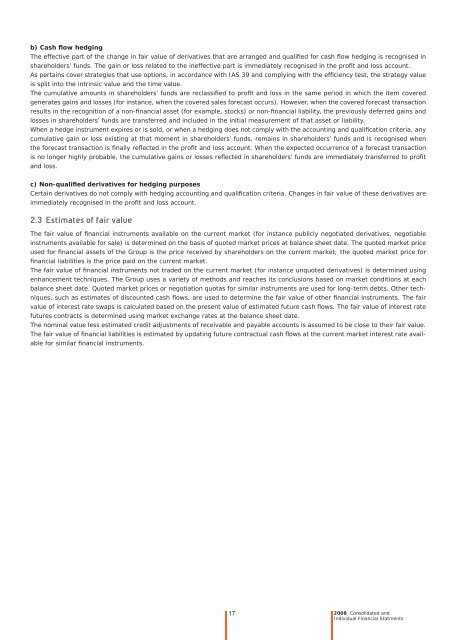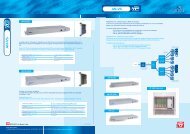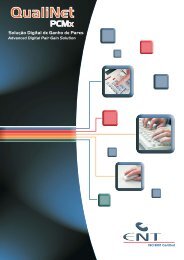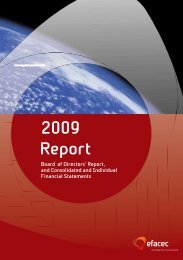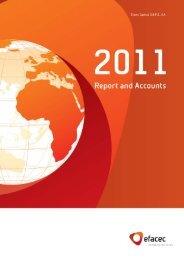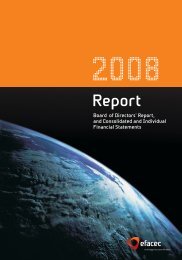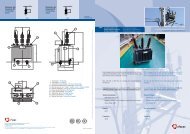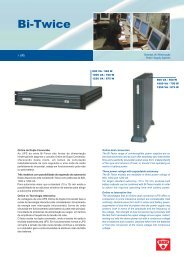Notes to the consolidated financial statements - Efacec
Notes to the consolidated financial statements - Efacec
Notes to the consolidated financial statements - Efacec
Create successful ePaper yourself
Turn your PDF publications into a flip-book with our unique Google optimized e-Paper software.
) Cash fl ow hedging<br />
The effective part of <strong>the</strong> change in fair value of derivatives that are arranged and qualifi ed for cash fl ow hedging is recognised in<br />
shareholders’ funds. The gain or loss related <strong>to</strong> <strong>the</strong> ineffective part is immediately recognised in <strong>the</strong> profi t and loss account.<br />
As pertains cover strategies that use options, in accordance with IAS 39 and complying with <strong>the</strong> effi ciency test, <strong>the</strong> strategy value<br />
is split in<strong>to</strong> <strong>the</strong> intrinsic value and <strong>the</strong> time value.<br />
The cumulative amounts in shareholders’ funds are reclassifi ed <strong>to</strong> profi t and loss in <strong>the</strong> same period in which <strong>the</strong> item covered<br />
generates gains and losses (for instance, when <strong>the</strong> covered sales forecast occurs). However, when <strong>the</strong> covered forecast transaction<br />
results in <strong>the</strong> recognition of a non-fi nancial asset (for example, s<strong>to</strong>cks) or non-fi nancial liability, <strong>the</strong> previously deferred gains and<br />
losses in shareholders’ funds are transferred and included in <strong>the</strong> initial measurement of that asset or liability.<br />
When a hedge instrument expires or is sold, or when a hedging does not comply with <strong>the</strong> accounting and qualifi cation criteria, any<br />
cumulative gain or loss existing at that moment in shareholders’ funds, remains in shareholders’ funds and is recognised when<br />
<strong>the</strong> forecast transaction is fi nally refl ected in <strong>the</strong> profi t and loss account. When <strong>the</strong> expected occurrence of a forecast transaction<br />
is no longer highly probable, <strong>the</strong> cumulative gains or losses refl ected in shareholders’ funds are immediately transferred <strong>to</strong> profi t<br />
and loss.<br />
c) Non-qualifi ed derivatives for hedging purposes<br />
Certain derivatives do not comply with hedging accounting and qualifi cation criteria. Changes in fair value of <strong>the</strong>se derivatives are<br />
immediately recognised in <strong>the</strong> profi t and loss account.<br />
2.3 Estimates of fair value<br />
The fair value of fi nancial instruments available on <strong>the</strong> current market (for instance publicly negotiated derivatives, negotiable<br />
instruments available for sale) is determined on <strong>the</strong> basis of quoted market prices at balance sheet date. The quoted market price<br />
used for fi nancial assets of <strong>the</strong> Group is <strong>the</strong> price received by shareholders on <strong>the</strong> current market; <strong>the</strong> quoted market price for<br />
fi nancial liabilities is <strong>the</strong> price paid on <strong>the</strong> current market.<br />
The fair value of fi nancial instruments not traded on <strong>the</strong> current market (for instance unquoted derivatives) is determined using<br />
enhancement techniques. The Group uses a variety of methods and reaches its conclusions based on market conditions at each<br />
balance sheet date. Quoted market prices or negotiation quotas for similar instruments are used for long-term debts. O<strong>the</strong>r techniques,<br />
such as estimates of discounted cash fl ows, are used <strong>to</strong> determine <strong>the</strong> fair value of o<strong>the</strong>r fi nancial instruments. The fair<br />
value of interest rate swaps is calculated based on <strong>the</strong> present value of estimated future cash fl ows. The fair value of interest rate<br />
futures contracts is determined using market exchange rates at <strong>the</strong> balance sheet date.<br />
The nominal value less estimated credit adjustments of receivable and payable accounts is assumed <strong>to</strong> be close <strong>to</strong> <strong>the</strong>ir fair value.<br />
The fair value of fi nancial liabilities is estimated by updating future contractual cash fl ows at <strong>the</strong> current market interest rate available<br />
for similar fi nancial instruments.<br />
17<br />
2008 Consolidated and<br />
Individual Financial Statments


